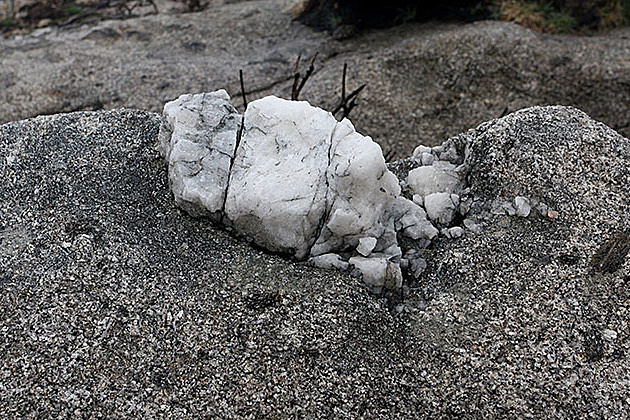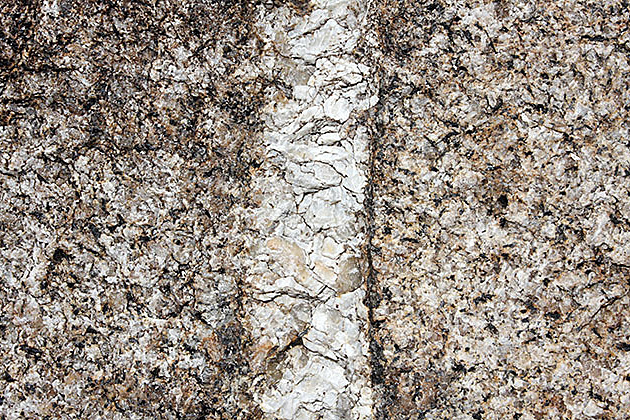O quartzo

O quartzo é um mineral muito comum, é um composto químico de silício e oxigénio, dióxido de silício SiO2, chamado sílica de um modo geral.
Quando puro, o quartzo é incolor, transparente e é um material cristalino muito duro e com aspecto vítreo. Os conhecidos cristais de rocha - prismas de seis lados com seis pirâmides nos topos - são simplesmente cristais de quartzo perfeitamente formados.
O quartzo ocorre em várias variedades coloridas, como a ametista (violeta), quartzo-citrino (amarelo), ou quartzo fumado (cinzento a castanho). Também pode ocorrer em formas densas sem cristais visíveis, como a multi-colorida ágata e o flint cinzento.
O quartzo é um mineral importante na formação de rochas, fazendo parte da composição de muitas rochas comuns, como o granito.
A palavra "quarz" (o "t" é omitido propositadamente) é conhecida na literatura europeia sobre mineralogia desde o século XIV. É provavelmente de origem germânica ou eslávica.
Filões de quartzo

O quartzo é muitas vezes encontrado em filões que cortam a rocha. Embora o termo filão, ou veio, possa sugerir que os filões de quartzo ou outros minerais sejam tubos finos, isso não acontece. São geralmente "folhas" finas. Os filões são formados devido a várias condições e dependendo das mesmas os filões podem apresentar ou não cristais de quartzo.
O tipo mais simples de filão de quartzo é o enchimento de uma fenda que já existia nas rochas. Esta fenda poderá ter sido formada durante o dobramento da rocha durante o processo de aparecimento de uma montanha, por quebra durante acontecimentos tectónicos, por uma diminuição da pressão durante a subida à superfície da rocha ou por causa da diminuição de tamanho da rocha devido ao seu arrefecimento
A salmoura quente que atravessa a rocha originária a grandes profundidades e a alta temperatura precipitará os minerais transportados em fendas a mais baixas temperaturas e pressões. Este processo continuará até a fenda estar totalmente preenchida ou poderá parar antes, deixando, neste caso, alguns espaços no filão que serão por vezes ocupados à superfície por cristais. A salmoura quente que entra numa fenda numa rocha distante da fonte quente como um plutão granítico arrefece e precipita os minerais que transporta de uma forma rápida. O resultado é um quartzo leitoso, com uma forma maciça ou feito de cristais de quartzo leitosos e entrelaçados. Depois, quando o crescimento cristalino diminui, o cristal poderá ficar menos opaco ou mesmo transparente. Na maioria dos filões de quartzo, a maior parte do quartzo é precipitado como um quartzo leitoso e maciço e os cristais bem formados, se forem encontrados, são só uma pequena parte do enchimento do filão.
ref: www.quartzpage.de, wikipedia
Euro
Escala de Mohs de dureza
Uma das maneiras para identificar um mineral é através da sua dureza. A dureza é a medida da resistência que um determinado mineral oferece ao risco, ou seja, à retirada de partículas da sua superfície.
Essa dureza é quantificada pela Escala de Mohs.
O diamante risca o vidro, portanto, é mais duro que o vidro. Esta escala foi criada em 1812 pelo mineralogista alemão Friedrich Vilar Mohs com dez minerais de diferentes durezas existentes na crosta terrestre.
Atribuiu valores de 1 a 10. O valor de dureza 1 foi dado ao material menos duro da escala, que é o talco, e o valor 10 dado ao diamante que é a substância mais dura conhecida na natureza.
Esta escala não corresponde à dureza absoluta de um material. Por exemplo, o diamante tem dureza absoluta 1500 vezes superior à do talco. Entre 1 e 9, a dureza aumenta de modo mais ou menos uniforme, mas de 9 para 10 há uma diferença muito acentuada, pois o diamante é muito mais duro que o coríndon (ou seja, que o rubi e a safira).
| Dureza |
Mineral |
Dureza absoluta |
| 1 |
Talco (pode ser arranhado facilmente com a unha) |
1 |
| 2 |
Gipsite (ou gesso) (pode ser arranhado com unha com um pouco mais de dificuldade) |
3 |
| 3 |
Calcite (pode ser arranhado com uma moeda de cobre) |
9 |
| 4 |
Fluorite (pode ser arranhada com uma faca de cozinha) |
21 |
| 5 |
Apatite (pode ser arranhada dificilmente com uma faca de cozinha) |
48 |
| 6 |
Feldspato / ortoclase (pode ser arranhado com uma liga de aço) |
72 |
| 7 |
Quartzo (capaz de arranhar o vidro. Ex.: ametista) |
100 |
| 8 |
Topázio (capaz de arranhar o quartzo) |
200 |
| 9 |
Corindo (capaz de arranhar o topázio. Exs.: safira e rubi) |
400 |
| 10 |
Diamante (mineral mais duro que existe, pode arranhar qualquer outro e é arranhado apenas por outro diamante) |
1500 |
|